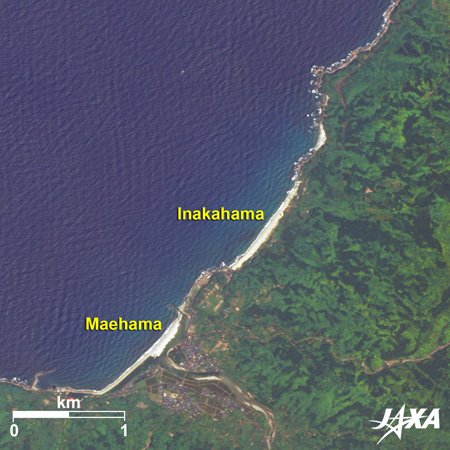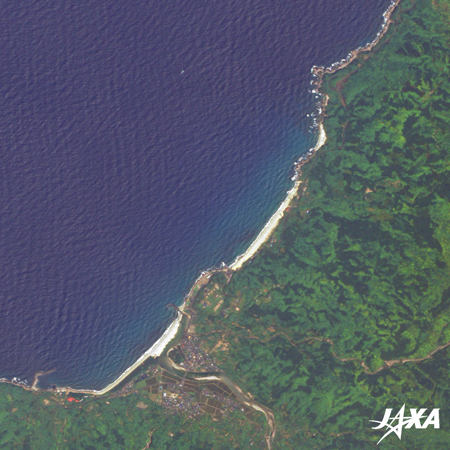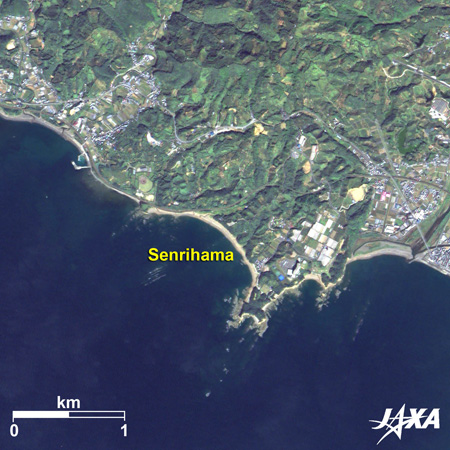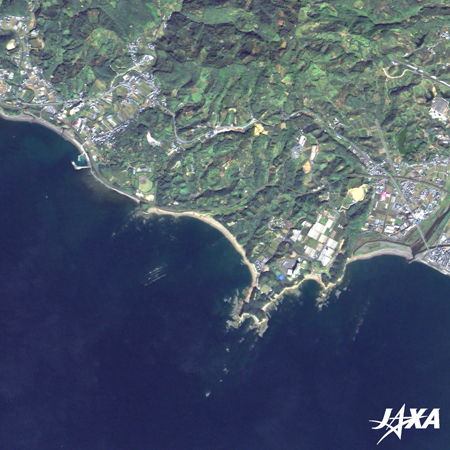Seen from Space 2014
The Egg-Laying Environment of Sea Turtles: Examples from Japanese Beaches
|
Sea turtles are large reptiles that rarely cause harm to humans. Japanese folk lore associates the sea turtle with the tale of Urashima Taro, who helped a young sea turtle that was being teased by boys on a beach, and in return received a favor from the turtle. In Okinawa, there are many popular tales of sea turtles that have helped people. Sea turtles are found mainly in the tropical and sub-tropical zone and within limited places in the temperate zone. They live in the sea, except when they come to the land to lay eggs. The Japanese Islands are surrounded by sea, and female sea turtles can be seen laying their eggs on the sandy beaches of the southern part of the Japan Islands, in the region of the Northern Pacific Ocean where the warm current of the “Kuroshio” exists. The loggerhead (Caretta caretta) sea turtle is commonly found around Honshu Island, and Japan is its only breeding ground in the Northern Pacific Ocean, (the northern limit being Ishikawa and Fukushima Prefecture). The green sea turtle (Chelonia mydas) has breeding areas in the southern part of Yakushima Island and the Ogasawara Islands, and the hawksbill (Eretmochelys imbricata) in the Yaeyama Group of Islands. Additionally, the olive ridley turtle (Lepidochelys olivacea), and the leatherback turtle (Dermochelyidae), can be seen in the oceans around Japan (Ref. 1). In Japan, the egg-laying time of turtles varies slightly from place to place, and takes place between May and August. The female turtle digs a hole on a sandy beach and lays about a hundred eggs therein. Egg-laying can occur several times in one season, and the eggs hatch in the sand between 45 and 75 days after being laid. The newly-hatched young turtles then climb up onto the sand and dash toward the sea where they join the Kuroshio Current, reaching the west coast of USA in about one year. From there, they transit to the current flowing towards Japan, and return to Asia in the East China Sea. After a period of maturing, which lasts about 20–30 years, they are thought to return to Japan to lay their eggs (Ref. 2, 3). The beaches of Yakushima and Fukiagehama in Kagoshima Prefecture, Miyazaki Prefecture, Kochi Prefecture, Wakayama Prefecture and Shima Peninsula in Mie Prefecture, are known as the breeding site of the loggerhead sea turtles. The famous sandy beaches of Maehama and Inakahama, where sea turtles lay eggs, in Nagata, Yakushima-cho, Kumage-gun, Kagoshima Prefectures is shown in Fig.1. (Image observed by “Daichi.”) Fig. 1.
The beaches of Inakahama and Maehama
Inakahama and Maehama (kmz, 5.33 MB, low-resolution) as seen on Google Earth Fig. 2 is the image of Senrihama, Senrihama, Minabe-cho, Wakayama Prefecture. It is in color with resolution 2.5m, processed from data of PRISM (Panchromatic, 2.5m resolution image) and AVNIR2 (Color, 10m resolution image) onboard “Daichi” (ALOS). Fig. 2. Enlarged Image of Senrihama
Senrihama (kmz, 4.29 MB, low-resolution) as seen on Google Earth The sea turtles (including the loggerhead sea turtle) that inhabit the seas around Japan are endangered species listed in Appendix I of the Washington Convention (or CITES: Convention on International Trade in Endangered Species of Wild Fauna and Flora) (Ref. 4). The decrease in the number of sea turtles has been attributed mainly to a number of factors such as the shrinkage of sandy beaches suitable for laying eggs, to the building of shore protection walls, the construction of wave dissipating concrete blocks, and the building of banks that prevent sea turtles from landing and laying eggs on the shore. To prevent the extinction and rapid decrease of wildlife species, any international commercial transaction involving the species listed in Appendix I is strictly prohibited, and the species cannot be bought or sold for any other purpose except academic research and breeding in zoological gardens (Ref. 5). Sea turtle conservation activities take place in many places throughout the world. These activities include the protection of environments suitable for laying eggs, the provision of support for hatching, and the protection of sea turtles caught as by catch. Usually, the young turtles hatched in Japan mature during their migration on the Kuroshio Current across the Pacific Ocean. However, some of them are being taken by the Tsushima Current to the Sea of Japan, and many survived young turtles were found at the coast of Sea of Japan this winter. According to the NPO Sea Turtle Association in Japan, the reason for the increase in the number of survived young turtles found there is not clear because the sea surface temperature was not lower than usual. It is hoped that the steady conservation activities that started in 1980 will soon result in an increase in the number of turtles. Plastic bags and other plastic objects have been found in the dissected bodies of dead turtles, which indicates that the turtles ate discarded plastic material waste. As the lives of human beings improve due to the consumption of convenience food packaged in plastic, the dumping of such waste products into the sea threatens the lives of sea animals and the stability of coastal ecosystems. It could be argued that the steady conservation activities related to sea turtles will contribute not only to the conservation of the species, but protecting beaches connecting the land to the sea will also lead to the creation of an environment that is mutually compatible for both humans and wildlife. Reference Site
Explanation of the Images:
PRISM is an optical sensor used for observing ground surfaces. It has visible and near-infrared signals in the 520- to 770-nanometer (one-billionth of a meter) band. The image is monochromatic but has a high resolution. PRISM has three independent optical systems for acquiring images in the view of nadir, forward, and backward simultaneously. The nadir image is used in the figure. |









